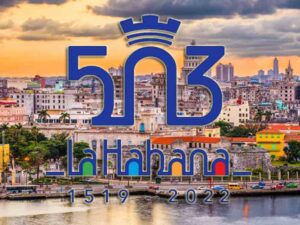A few hours before November 16, the people of the Cuban capital, one of the oldest cities in the Americas, keep alive the traditional three times walk around that symbolic tree at the Greco-Roman temple known as “El Templete”, where they ask at the foot of its trunk for good luck and fortune for the city and its inhabitants.
The ceremony takes place in the site from where the village grew, according to the evidence by the then Havana governor, Francisco Cagigal, who also ordered a plaque to conserve the deed, perpetuated later by Francisco Dionisio Vives, with the construction of the building that is currently part of that foundation´s tradition.
The Templete, like other buildings in the historic district, speaks of the history and culture of an imperious city, of a particular beauty that stands the test of time with the program of the Office of the Historian of the City, conceived and promoted by the late Eusebio Leal Spengler.
Thanks to its restoration and conservation work, the oldest district of Cuba’s capital was declared a World Heritage Site by the United Nations Educational, Scientific, and Cultural Organization (UNESCO) in 1982 and was designated a Wonder City of the Modern World in 2016.
jrr/iff/oda/yrv
CUBA-HABANA
Villa de San Cristóbal de La Habana arriba a 503 cumpleaños
La Habana, 16 nov (Prensa Latina) En 1519 aconteció la primera misa y cabildo a la sombra de una ceiba que marca el sitio fundacional de la villa de San Cristóbal de La Habana, hoy digna de sus 503 años.
El pueblo de la capital de Cuba, una de las urbes más añejas de América, mantiene viva la tradición de dar la vuelta tres veces a aquel simbólico árbol, en un templo greco-romano conocido como Templete, unas horas antes del 16 de noviembre y pedir al pie de su tronco bienaventuranzas y fortuna para la ciudad y sus habitantes.
La ceremonia acontece en el lugar desde donde creció la villa, según las pruebas del entonces gobernador de la isla, Francisco Cagigal, quien mandó a eregir una tarja para perpetuar el hecho que más tarde perpetuó Francisco Dionisio Vives con la construcción del edificio que forma parte de esa tradición fundacional.
Este inmueble, al igual que otros tantos del Casco Histórico hablan de la historia y cultura de una urbe imperiosa, de una belleza particular que se impone al paso del tiempo con el programa de la Oficina del Historiador de la Ciudad, ideado e impulsado por Eusebio Leal Spengler.
Gracias a su labor de restauración y conservación, la zona más antigua de la capital de Cuba obtuvo la declaración de Patrimonio de la Humanidad por la Organización de las Naciones Unidas para la Educación, la Ciencia y la Cultura en 1982, y ganó además el título de Ciudad Maravilla del Mundo Moderno en 2016.
oda/yrv










